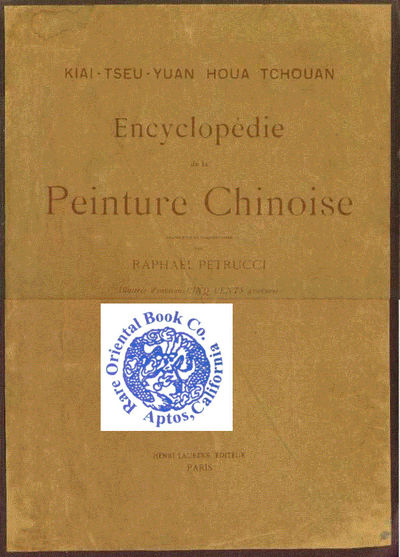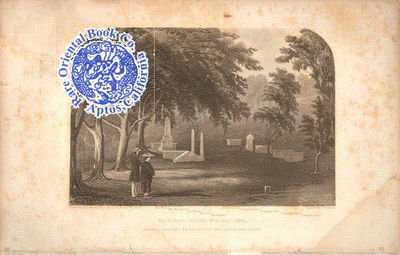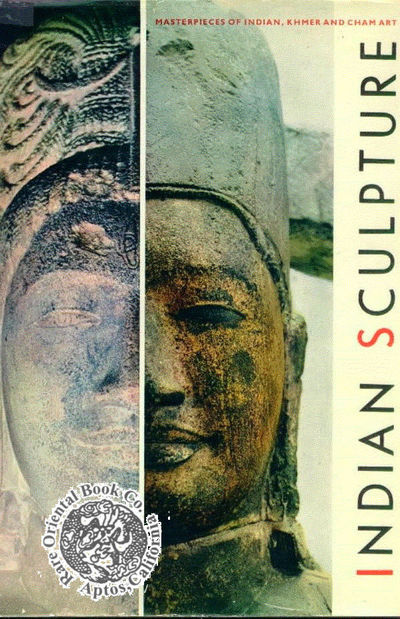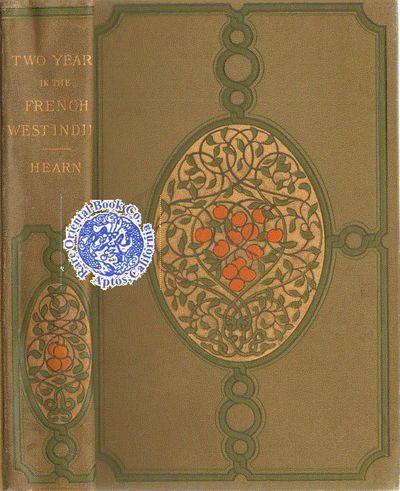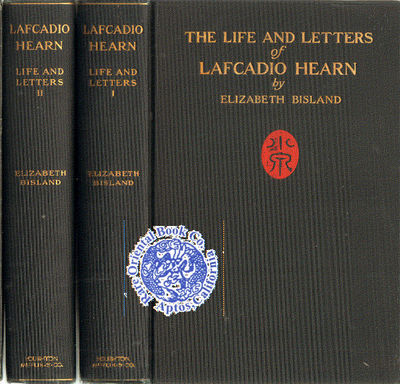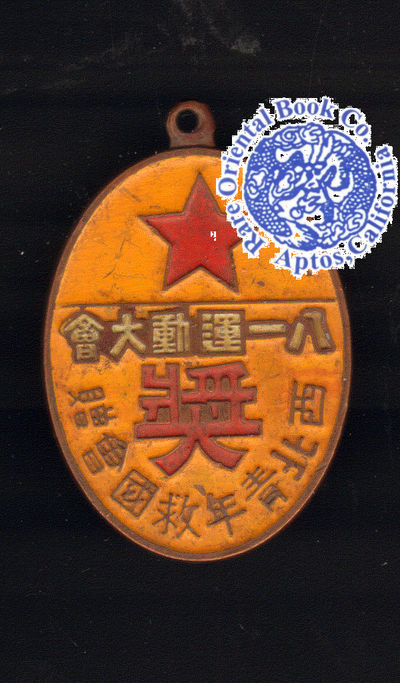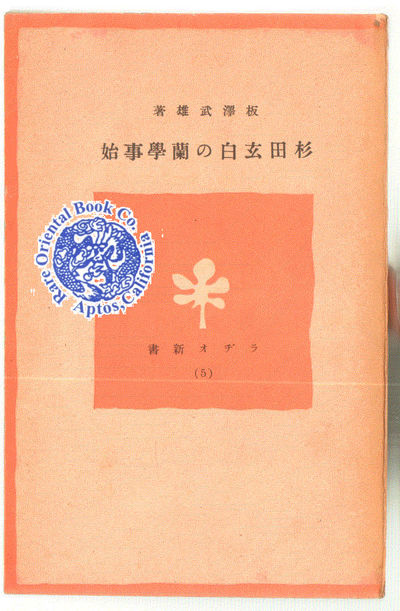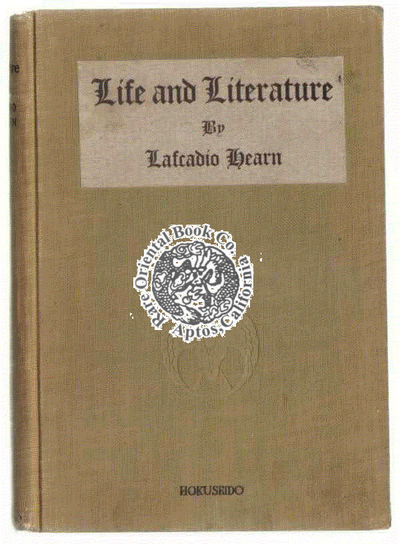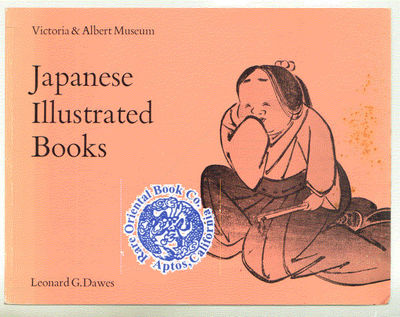
DAWES, Leonard G.
London 1972, HMSO. Stiff wrs., very good 15p. text + 1 color frontis,+60p. b.w. photos, 24.4 X 8.5 cm., very clean, solid a tiny bit of stain to front right edge cover,else very good example. * * FIRST & ONLY EDITION * * . *** **** *** . . EXCELLENT CATALOGUE FROM THE VICTORIA & ALBERT MUSEUM . . . OF JAPANESE WOODBLOCK PRINTED BOOKS [E-HON] . . . ILLUSTRATING & DESCRIBING 60 ITEMS . . * An excellent reference for E-hon [Japanese woodblock printed & illustrated books]. . Each of the 60 entries has a full description of the book, author & his dates, title, size, subject, full bibliographical citations. and collection number in the Victoria & Albert Museum collection. . *** Color photos are posted to our website. . *** CONDITION: This is bound in the original publisher's illustrated wrapper, a bit of spotting to front cover right margin, else contents pristine, no issues. . *** A useful illustrated bibliography, covering a wide variety of artists & subjects, including people, animals, insects, birds, flowers, fish, monkey, mouse, cat & dog, Kimono, Japanese ladies, men, Samurai, scenery, common folk at daily activities, folk craft, sword maker &c. . * .
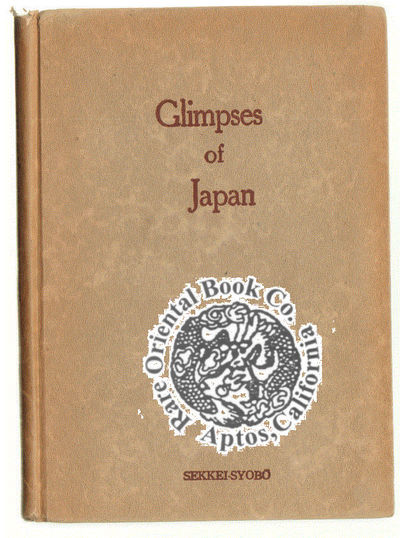
HEARN, Lafcadio.
[Tokyo 1941], Sekkei-Shobo. Boards, title printed on the front covers, 128p., clean and solid, a bit of wear to spine head, else clean, solid & firm, English text, 13 x 18.5 cm., a very good example, contents bright no issues. . *** **** *** . . . * CONTENTS: . MY FIRST DAY IN THE ORIENT . THE JAPANESE SMILE . THE RELIGION OF LOYALTY . THE GENIUS OF JAPANESE CIVILIZATION . IN A JAPANESE GARDEN. . *** These essays were used by Japanese students of English and English Literature as a study guide, commonly they are full of annotations, translated words and annotations. This 1941 copy is very clean and bright . *** Color photos are posted to our website. . *** REFERENCE: . Not in Perkins . * .

GOETTE, John.
Shanghai 1936, Kelly & Walsh. Green cloth, 321p., index, 1 color frontis, 96 b.w. photos, 5 drawings, index, color Jade spectrum chart, 18.5 x 24 cm., very clean, solid and firm example. FIRST EDITION . *** **** *** . . A STANDARD CLASSIC REFERENCE . . . ON CHINESE JADES & HARD STONES . * This scholarly and authorative work covers the past thirty centuries of Jade. . Definition of the stone, its source, industry, colors, imitations, related stones, uses in stone age civilization, religious & ceremonial use, music application, Jade mountains and imperial pieces and adornment. . The various motives, designs, Chinese character, found in literature & mythology. . A comprehesive and copious resource source book, valuable for scholars, students, collectors, museum curators and dealers. . Printed on heavy rag paper, well done. . *** .

UEDA, Reikichi.
Rutland [1961], Tuttle. Buff cloth, 226 color & b.w. photos 325p., index, dj., very clean, solid. FIRST EDITION RAYMOND BUSHELL'S SIGNED PRESENTATION COPY This is an important reference source for any collector of Japanese Netsuke, compiled under the watchful eye of Bushell and organized for easy use. Addressing Netsuke as related to the history of sculpture. * Netsuke & its types, origin and development of Netsuke, Netsuke with secondary functions, Netsuke & the tobacco pouch, Netsuke materials: wood, ivory, horn, metal, porcelain, lacquer & other materials. * Netsuke subjects & designs. The Netsuke artists. Regional characteristics of Netsuke: Kansai, Edo, Chukyo & other districts. With an appreciation of Netsuke, its decline, export of, observations on all periods: Early, Middle & Late. * Literature on Netsuke & Netsuke collections. Reminiscences of Netsuke carvers: a visit to Koun Takamura &c. A valuable and most reliable study. * .

ISHIMOTO, Kikuji.
Tokyo 1962, Ishimoto Architectural & Engineering Firm. Stiff wrappers, [36] pages, map, 54 b.w. photos, 19 architectural drawings/plans, English text, 44.3 x 25 cm., very good,clean example. FIRST & ONLY EDITION . *** **** *** . . TRADITIONAL STRUCTURES WITH A JAPANESE FLAIR . . * Ishimoto Architectural Co., was honored by the Japanese Emperor in 1958 when they were awarded the Blue Ribbon Medal. . The firm is known for its stunning work, including the rebuilding of the Hiroshima castle. . An interesting insight to Japanese design, interiors, Wabi, Sabi and other Zen concepts translated into architecture. . * .

HEARN, Lafcadio.
Boston 1922, Houghton.Brown cloth over brown boards, vol. 11 ONLY,15 x 23 cm.,2 titles:KOTTO & KWAIDAN titles, ex-private library copy, spine, edges, corners worn sold "as is."1ST ED FIRST LARGE PAPER EDITION LIMITED 750 NUMBERED #587 ODD VOL. . *** **** *** . . THE COMPLETE 16 VOLUME SET . . . CONTAINING ALL OF LAFCADIO HEARN'S WRITINGS . . . LARGE PAPER EDITION . . . THE FIRST LIMITED & HAND-NUMBERED EDITION OF 750 COPIES . . . RARELY FOUND, A SUPERB & PRISTINE UNCUT EXAMPLE . . . IN ORIGINAL WHITE PAPER DUST JACKETS [see below] . . . SIGNED & RED CINNABAR HANKO [CHOP/SEAL] BY HEARN'S WIFE . . *** This set comprises Lafcadio Hearn's complete writings. It covers all of his published titles up to his death in 1904. . *** Bound in the original publisher's brown cloth spine with brown paper label printed in gold over brown paper boards. . An UNCUT bright example, edges untrimmed as issued, with red & black ink printed title pages, Each volume has a superbly clean & bright brown paper label [matches the covers], printed in gold, showing: author, title & volume number. . FIRST & ONLY LARGE PAPER, LIMITED & NUMBERED EDITION OF 750: . Each volume has the LIMITATION STATEMENT, hand-numbered in pen, in an edition of 750 copies on the verso of the title page. . Each volume also has the superbly & RARELY found original white paper dust jackets, with identical spine text per above, but printed in black. This dust jacket is special, It is a large, and over-sized, so that the long edges are folded-over the book edges on all sides thus protecting the book. These are RARELY if ever found intact or complete. This example is a truly RARE and excellent copy. . *** THE CONTENTS: . Vol.I: DIARY OF AN IMPRESSIONIST, & CREOLE CREOLE STORIES, & CHINESE GHOSTS.[CREOLE SKETCHES first appearance] . Vol.II: STRAY LEAVES FROM STRANGE LITERATURE, FANTASTICS & . OTHER FANCIES. . Vol.III: TWO YEARS IN THE FRENCH WEST INDIES. . Vol.IV: TWO YEARS IN THE FRENCH WEST INDIES, CHITA, YOUMA. . Vol.V, VI: GLIMPSES OF UNFAMILIAR JAPAN. . bound in two volumes.. . Vol.VII: OUT OF THE EAST & KOKORO. . Vol.VII: GLEANINGS IN BUDDHA FIELDS & . ROMANCE OF THE MILKY WAY. . Vol.IX: EXOTICS & RETROSPECTIVES, IN GHOSTLY JAPAN. . Vol.X: SHADOWINGS, & A JAPANESE MISCELLANY. . Vol.XI: KOTTO & KWAIDAN. . Vol.XII: JAPAN AN ATTEMPT AT INTERPRETATION. . Vol.XIII-XV: LIFE AND LETTERS. [bound in three vols.] . Vol.XVI: JAPANESE LETTERS. . *** THE COLOR & SEPIA TONE PHOTOGRAPHIC PLATES: The set is finely illustrated with a large number of fine color photographs by Charles S. Olcott, with color photograph frontispieces in each volume, plus many text photographs. . *** NOTE: This LARGE PAPER EDITION was published to benefit the Koizumi [Lafcadio Hearn's Japanese name] family members: his wife Setsuko and three young children posthumously. . *** ILLUSTRATIONS: The work is nicely illustrated with color photographs by Charles S. Olcott, each is tipped in with tissue guards. The sepia-tone photos are also very sharp, none with fading. . *** Color photographs are posted to our website. . *** CONDITION: . The Bindings: The books are PRISTINE, NEW & UNUSED superb examples, completely uncut as issued. The finest copy we have had in over fifty-five years of tenure! . Dust jackets: [NOTE: NOT ALL COPIES HAVE THE DUST JACKETS PLEASE CAREFULLY READ THE DESCRIPTION OF EACH COPY. . With The Exceptionally RARE Dust Jackets: The white paper dust jackets are on each of the 16 volumes. Being almost 100 years old, these dust jackets will have some of the usual & typical rubbing, small closed tears, archival tape [or old Scotch-tape] mends and other normal signs of usual, minor storage and age. By and large these are very unusually fine examples. Spine labels are superb, fresh and without rubbing, fading or issues. The gilt spine label lettering is fresh and bright. . Contents: The uncut contents is pristine, clean and solid, top edges folded [i.e. uncut], fore and lower edges untrimmed as issued. . It would be impossible to find a more stunning and superb example. "Superb" would be an extreme understatement ! . *** Color photos are posted to our website. . *** BIBLIOGRAPHY: . BAL: 79817976, 7977, 7981 * P.D. & I. Perkins: LAFCADIO HEARN A BIBLIOGRAPHY OF HIS WRITINGS: p.81-4. . * .
![LAFCADIO HEARN HERUN. A Journal Of The Yakumo Kai [Hearn Society] Of Matsue Japa](data:image/gif;base64,R0lGODlhAQABAAAAACH5BAEKAAEALAAAAAABAAEAAAICTAEAOw==)
HEARN, Lafcadio.
[Matsue 1988, Yakumo Kai. Stiff color pictorial wrappers, an unused, NEW example, No.26,many b.w. photos, 152p., essays by Hearn scholars, by/about Hearn in Japan, 15 x 21 cm.,text in Japanese, some English. FIRST & ONLY EDITION . *** **** *** . . THE FIRST & ONLY EDITION . . * A journal issued by the YAKUMO KAI [Hearn Society] of Matsue. . It contains fascinating articles by various Hearn scholars, former students and others including essays by, about Hearn. . Issued in a small FIRST & ONLY edition, nicely illustrated, with some text in English. . *** CONDITION: This is a NEW, UNUSED example. . *** Color photos are posted to our website. . * .

[HUNTER, William C.]
Taipei 1965 Ch'eng Wen. Black cloth, reprint of London 1882, very good, clean, 157p., frontis portrait of Houqua, 12.3 x 19 cm. *** *** *** . . . ONE OF THE EARLIEST FIRST-HAND AMERICAN ACCOUNTS . . . OF CANTON AND THE BEGINNING OF AMERICAN TRADE . . . IN THE PRE-TREATY CITY OF CANTON . *** THE AUTHOR: WHO WAS WILLIAM C. HUNTER [1812-1891]: . The author was an American merchant and author, born in Kentucky. He apprenticed to the Canton, China agency, of Thomas H. Smith & Sons of New York from 1825-1829, and was employed as a clerk with Russell & Co. from 1829 until 1842, when he became a partner in that company. He studied at the Anglo-College in Malacca and was probably the first American to devote himself to the systematic study of both the spoken & written Chinese. He lived in Macao after 1842, and was part owner of Midas, the first American steamship to ply the Chinese waters. . Hunter authored two books on China: this current title, and his second book, see the bibliography below for details. .. *** . A CLASSIC AND FAMOUS AMERICAN PRIMARY WORK ON CANTON: This fascinating primary work is partly based on the authors employment in early Canton. It also covers the history of early intercourse of foreigners with the people of China. Hunter Sr. died in June of 1891 a few days after the failure of the firm Russell & Co. . This work also covers the "Foreign Barbarians" who lived & worked on the banks of the Choo or Pearl River, no port other than that of Canton was open, nor had there been one since 1745 and no foreigner was permitted on any pretext to enter the country or even the city outside of which he lived. . * A wonderful early insight to the true life & events of the residents and their relations with the Chinese. A major and early resource for Canton and the foreign factories. . *** ABOUT THE FIRST EDITION: The First Edition contains an original photograph frontispiece of a the famous and most celebrated pith painter Houqua, who was know to produce stunning souvenir hand-painted color pictures and albums of Chinese life as well as doing portraits of foreigners. . *** Nicely done, loaded with great insights to life in the Canton area by an old China hand. With a lovely map and plan of the Island of Honam & the thirteen factory streets, which shows the locations of the Dutch, Spanish, French, Chon Qua, American, Paou Shun, Imperial, Swedish, E.J. Company Old, Chow Chow, E.J. Company New, Dutch and Creek factories, including that of Houqua and other Chinese painters who also did similar color paintings like Houqua, linguists, and others, all clearly outlined and identified on this map. . *** ABOUT THE THIRD EDITION: This edition contains a preface dated Shanghai, March 1938 by the editor of 'Oriental Affairs' [the publisher] wherein he identifies the true author who used the pseudonym of 'An Old Resident' to be William C. Hunter. . This edition also contains the essay: "MESSRS. RUSSELL & CO., CANTON 1823 TO 1844. . *** COLLECTOR'S NOTE: Please visit our website, as we may also have Hunter's second title: BITS OF OLD CHINA, and other items about early China trade, treaty ports, Canton, Hong Kong and foreigners in early China. . *** BIBLIOGRAPHY: Henri Cordier.: BIBLIOTHECA SINICA 2284 * William C. HUNTER.: BITS OF OLD CHINA, London 1855 * .

GOLDMAN, Israel.
[London 2005, Goldman]. CATALOGUE 11. Stiff brown wrappers, 21 x 21 cm., price list, 69 well described & color photos of each item, excellent copy, bright, clean & solid, no issues, like NEW. * * FIRST & ONLY LIMITED EDITION OF 700 COPIES * * . *** **** *** . . SUPERBLY COLOR PHOTOS OF EACH ITEM . . . EACH CAREFULLY DESCRIBED & PRICED IN U.S. $ . . * CONTENTS OF EACH CATALOGUE: . No.10: Koryusai, Harunobu, Shunei, Shunsho, Shuncho, Utamaro, Toyokuni, Shunga [erotica], Hokushu, Kunimaru, Hokumyo, Shigenobu II, Hokkei,Shikabei, Eizan, Hokusai, Sadahide, Gakutei, Eisen, Hokuba,Kuniyasu,Kunisada, Kuniyoshi, fan prints, Hiroshige, Yoshikazu, Americams in Japan, foreigners in Japan, Yokohama prints, Yoshimori, Yoshitora, Yoshitoshi, Kunichika, Toshinobu, Seiho & Kiyochika. Price list tipped in. . No.11: Masanobu, Harunobu, Koryusai,Buncho, Shunko,Shunan, Utamaro, Toyohiro, Shunga [erotica], Kunisada, Toyokuni, Taito II, Masayoshi, fan prints, Sosen, Hokusai, Hiroshige, Shigenobu,Gakutei, Hokkei, Eisen, Kuniyoshi, Hiroshige II, Kunisada, Yoshitoshi, Kiyochika, Tadamasa, Kyosai, Zeshin & Seiho. Price list tipped in. . No.12: Okumura, Harunobu, Shunsho, Shigemasa, Shunko, Kiyonaga, Utamaro, Shunga [erotica], Tokei, Hokkei, Sadakage, Shigenobu, Kunisada, Sadahide, Eizan, Hiroshige, fan prints, Hokusai, Kuniyoshi, Yoshitsuya, Hiroshige II, Americans in Japan, Yoshitoshi, Kiyochika, Toshihide, Kunichika, Chikanobu, Zeshin, Koshu, Kyosai, Seitei, Koson, Gekko & Tsunetomi. Price list tipped in. . No.13: Toyonobu, Harunobu, Koryusai, Kiyonaga, Shuncho, Shun'ei, Toyokuni, Eiri, Eishi, Shunga [erotica], Utamaro, Masayoshi, Hokusai, Kunisada, Shigeharu, Hirosada, Gakutei, Kuninao, Kuniyoshi, Oshin, Eisen, Sadahide, fan prints, Hiroshige, Hiroshige II, Kunichika, Yoshitora, Yoshikazu, foreigners in Japan, foreigners in Yokohama, Yoshitoshi, Seitei, Tadakiyo & Keinen. Price list tipped in. . No.14: Kiyonobu, Harunobu, Koryusai, Shunga [erotica], Shun'ei, Sumo, Toyokuni, Shunsho, Shunsho, Eizan, Utamaro, Kyosai, Ehon [woodblock illustrated] books, similar to above contents. Price list tipped in. . No.15: similar to above contents. Price list tipped in. . No.17: similar to above contents. Price list tipped in. Slight peeling of lower right corner plastic laminate protector. . No.21: similar to above contents. Price list tipped in. Slight peeling of lower right corner plastic laminate protector. . No.22: similar to above contents. Price list tipped in. . No.23: similar to above contents. Price list tipped in. . No.24: similar to above contents. Price list tipped in. . No.25: similar to above contents. Price list tipped in. . No.26: similar to above contents. Price list tipped in. . *** Color photos are posted to our website. . *** CONDITION: Each catalogue is UNUSED, in like NEW condition, covers uncracked and opened. There is a tiny bit of the usual, minimal corner wear, by and large superb examples, contents likewise. . Any other small issues are cited above under each catalog number. . * .

[SAITO, Ryusuke
[Kyoto 1986, Shikosha]. Stiff pictorial wrs., 22 x 29.8 cm., 112 color photo plates,English title page, discussion, plate list, balance in Japanese,slight damp stain on leading edge, else contents clean & solid copy. FIRST & ONLY EDITION *** **** *** . . . IMPRESSIVE KUTANI WARE REFERENCE . . . CATALOG ILLUSTRATING 102 PIECES IN FULL COLOR . . * The Ishikawa Prefectural Art Museum holds the largest collection of Kutani ware in Japan. . This valuable reference covers a large number of old Kutani items from 1604-1889 [Edo-Meiji] periods. . Each item is photographed 3 times, showing top, bottom and seal in full color. Others in black & white, each carefully described, numbered. . With Kutani kiln map, chronology of Kutani ware. . With an addendum: items 99-102 tipped into inside of back cover. . A comprehensive reference, valuable resource. . *** CONDITION: The work has some minor, clear damp staining mostly to the leading edge, item sold "as is" not returnable or refundable. By ordering you agree to these terms. . *** .
![KIRK'S JAP ROSE SOAP. [1920 Color Advertising Sheet]](data:image/gif;base64,R0lGODlhAQABAAAAACH5BAEKAAEALAAAAAABAAEAAAICTAEAOw==)
KIRK, James S. & CO.
[New York 1920, Scribner's Magazine]. A color page extracted from the journal, 17 x 24 cm., gently removed, no damage, a bright & clean example, beautifully drawn by Milo Winter. * * FIRST & ONLY EDITION * * . *** **** *** . . A SUPERBLY QUAINT & CHARMING COLOR ADVERTISEMENT . . . FOR KIRK'S JAP ROSE SOAP, 1920 . . . BEAUTIFULLY COLOR DRAWN & PAINTED BY MILO WINTER . . * This charming art work shows a Japanese girl in traditional 1800's period costume, carrying two baskets with a bamboo pole over her shoulder. Each basket is full of "JAP ROSE SOAP." As she gracefully saunters on her way, she drops a bar of soap into the creek below. The walking bridge is a typical Japanese 'Half-Moon" shaped style found in Japan, orange with wooden planks. The girl wears a traditional farmer's conical hat, Haori short jacket, and tight leggings, with Zoori [common rice straw sandals]. . The creek is full of water iris, and a young boy prepares to catch the soap bar. . A young Japanese girl holds a bar of soap, while her mother assists in washing. Her wooden tall Geta [shoes] are by her side, as she kneels on a straw cushion. . In the lower right corner is a bar of the soap with colorful wrapper, showing another Japanese girl in Kimono. . There is a paragraph of text under the bridge, reading: "Pure, as Gold Transparent as Truth--that's Jap Rose Soap You'll like it !" . Followed by: "HOW THE KIDDIES DO LOVE THE GOLDEN TRANSPARENT, DELICATELY FRAGRANT JAP ROSE ! And how thoroughly and hygienically the magic, cleanse every pore of their tender skins. The Pure vegetable oils and c.p. glycerine [sic], blended so scientifically in JAP ROSE Soap, soothe and refresh, and rinse easily, leaving no sediment. An unusual value at two cakes for a quarter...James S. Kirk & Co., Chicago..." . *** THE FAMOUS ARTIST & CHILDREN'S BOOK ILLUSTRATOR: Milo WINTER [1888-1956]: . He was an American children's book illustrator. He created superbly beautiful and sensitive illustrated editions of Aesop's Fables, Arabian Nights, Alice in Wonderland, A Christmas Carol, Gulliver's Travels, Tanglewood Tales and many others. . He trained at Chicago's School of the Art Institute. He was the art editor of CHILDCRAFT books and from 1949, was the art editor in the film strip division of Silver Burdett Company. . His art is well collected and valuable. . *** Color photos are posted to our website. . *** CONDITION: This page was gently and expertly extracted from the journal in pristine condition, with 4 tiny staple holes as issued in the right margin. . The art work is remarkably still fresh, flawless, ready for matting and framing even though it is over 100 years old ! . It is as excellent as the day it was issued, no fading or other distractions. . *** REFERENCE: Milo Winter: en.wikipedia.org/wiki/Milo_Winter . * .

PETRUCCI, Raphael.
A typed manuscript, English translation of the section on CHINESE PAINTERS, A4 size, 3-hole punched paper, toned paper as usual, [29] pages, typed on both sides, brass tab holder, excerpt from the book.* FIRST & ONLY KNOWN ENGLISH EDITION * . *** **** *** . . THE FIRST MONOGRAPH ON THE MUSTARD SEED GARDEN . . . IN A EUROPEAN LANGUAGE . * This is a wonderful work, with superb detail coverage of the JIE ZI YUAN HUA ZHUANG HUA NIAO PU: MUSTARD SEED GARDEN. GUIDE TO PAINTING, a Chinese classic by Li Li-Ong & Wang Kai in 1679. . * This work discusses and illustrates a great portion of the original with additional commentaries. Hailed as the most important Chinese book on painting ever issued, it has been a continual source of instruction for Chinese and Japanese as well as for Western artists over the centuries. This covers landscapes, flowers, flowers, birds and figures, with critical notes on the principles and technical advice on painting. . * Useful analyses of the methods of drawing, for landscapes and for flower & birds. This superb work was begun in 1677 and finished in 1679. It has become a classic of Ming & Ch'ing painting, and a guide to both scholars & artists throughout China. . * A major European reference on this great Chinese classic, few works in Western languages were written about this book therefore this is the one single and most copious of any resource. Issued in a huge folio size, 30 x 41 cm. over all in heavy rag paper, a monumental work ! . *** End of the book description. . *** **** *** . . NOTES ON THE SEPARATE ENGLISH TRANSLATION TYPED MANUSCRIPT: . TITLE: THE CHINESE PAINTERS This is a typed manuscript, from the Justin D. Metzgar collection. This translation consists of the following parts from the original book in French. This is the only known translation excerpt to have been don’t on this classic title . This item is sold separately from the above described book. . Preface Part I: THE TECHNIQUE: 1. Tools of the painter 2. The representative of forms 3. The division of subjects 4. Inspiration . Part II 1. Origins 2. Chinese painting before the coming of Buddhism 3. The intervention of Buddhism 4. Chinese painting in the T'ang Epoch [7th-10th centuries] 5. Painting in the Sung epoch [10th to 13th centuries] 6. Chinese painting in the Yuan epoch [13th to 14th . centuries] 7. Chinese painting in the Ming epoch [14th to 17th . centuries] 8. Chinese painting in the Ch'ing epoch [17th to 20th . centuries] . 9. Conclusions . INDEX OF PAINTERS by dynasty [epochs] per above. . The above is the excerpt is the only translated part into English. A useful resource. . See spine.jpg photo posted to our website for the title page of this item. Other photos are of the Petrucci book. . End of typed manuscript item. . *** BIBLIOGRAPHY . K. Toda: THE RYERSON COLLECTION OF JAPANESE AND CHINESE ILLUSTRATED BOOKS, p.406-410. * J. Needham, SCIENCE AND CIVILIZATION IN CHINA: vol.3, p.596 et al for more details. * SZE, Mai-Mai: THE TAO OF PAINTING: A Study of the Ritual Disposition of Chinese Painting. With Translation of the Chieh Tzu Yuan Hua Chuan or Mustard Seed Garden Manual of Painting 1679-1701. Please inquire with us as we may have this in stock. * RAWSON, Jessica. ed. et al.: THE BRITISH MUSEUM BOOK OF CHINESE ART.: page 124. * .

WENTWORTH, REV. DR.
[Cincinnati 1830's], Ladies Repository.A single etched print sheet:26 x 16.2 cm., print size: 17 x 11.3 cm., extracted from an unknown issue of the journal,very solid, typical old small foxing spots, faint margin stain, else nice. RARE . *** . A VERY GOOD EXAMPLE OF THE PLACE . . SEVERAL AMERICAN MISSIONARIES WERE BURIED . * This engraving was drawn by J.D. Millis from a sketch by the Reverend Dr. Wentworth. The work was engraved by Theo. Stephens. This was "Drawn & Engraved Expressly for the Ladie's Repository." . The several graves are being viewed by Rev. Wentworth and an unidentified Chinese. Each grave is clearly named in the captions under the etching: A. Mrs. Wiley, Mrs. Wentworth [the Reverent's Wife], Mrs. White, Mrs. Peal, Mrs. Doolittle, Maclay's child, Swedish child, Hickock's child, Cumming's child, Baldwin Child. . * The above mentioned missionaries were mostly quite well know as those who worked in China, and around the Foochow area such as Xiamen. . *** This example was most likely extracted from the journal, as a keepsake for one of the missionaries. . * Color photos are posted to our website. . *** CONDITION: There are two faint water stains to the upper left and lower righrt corner margins, for the most part these do not impact the image. . * .

DENECK, Marguerite-Marie.
London [1970], Hamlyn. White gilt-stamped cloth, very good 32+[232]p., 5 color photos, 259 b.w. photos, dustjacketd in mylar protector, revised edition. . *** The sculptures represented in this book are taken from the famous collections at the Musee Guimet and the British museum. . * Their beauty has been admirably caught by the well- known photographers W. & B. Forman. A selection of the bes work from Khmer and Cham has also been included. This also includes a brief but concise outline of the background that produced these masterpieces. . * Addressing the historical background, development of Indian sculpture, spread of Indian thought: Khmer & Cham art. . * An excellent monograph & reference resource, English text. . *** Color photos are posted to our website. * .

MAO, Tse-tung.
Beijing 1976, Waiwen Chuban She. Stiff wrappers,very clean & solid, English & Chinese text, 13 x 20.9 cm.,large facsimile fold out of Mao's calligraphic poem, 107p.,sepia-tone photo frontis of Mao. * RARE FIRST EDITION FIRST PRINTING * . *** **** *** . . THE RARE TRUE FIRST EDITION FIRST PRINTING . . Cover's a collection of 36 poems from 1925-1965. Texts in both English and Chinese, with large fold out of Mao's calligraphic facsimile Mao poem "Loushan Pass." . *** Color photos are posted to our website. . *** THE EDITIONS: . We have 2 variant copies: . a. RARE TRUE FIRST EDITION FIRST PRINTING. In stiff wrappers with red & black ink English only title. On the front & back covers is a red date stamp reading: "1976 May 19," indicating the earliest and true FIRST EDITION FIRST PRINTING. . b. FIRST EDITION, FIRST REPRINT edition. In stiff wrappers with English & Chinese character titles in red and black ink. . See our cover.jpg on our website, left side is copy 'a', right side is copy 'b. . See our spine.jpg for the colophons of each edition: left side being copy 'a'; right side being copy 'b.' . *** .

FOREIGN AFFAIRS ASSOCIATION OF JAPAN.
Tokyo 1958, F.A.A.J. Blue stiff wrappers, very clean, solid, April, no. 2, vol. xxv, pp. 173-314, paper a bit 'toned' as usual, color & b.w. illustrations, ca. 17 x 24 cm. FIRST & ONLY EDITION This is an important World War II group of "official policy" declarations by the Japanese government. Much can be also stated to be "propaganda" for the benefit of the Japanese military and their war on America, Britain, China, Singapore, Thailand & Vietnam. Also contains many documents expounding the official Japanese text of various agreements, complaints and other official comments, often by famous Japanese politicians and later to be convicted "War Criminals," some of who were hanged by the tribunal after the war ! . Being entirely in English, the Japanese surely directed their comments to the enemy English-speaking world for the most effect. It was a huge "propaganda" effort to translate each month's political position papers, documents and other artistic essays, one is at a loss to understand the Japanese concept of engaging in a war with America and Britain, while still providing artistic, articles on Japanese art, culture and other non-war related essays in English. . During 1942 was a "watershed" and historic group of actions that reflected the temporary strength of the Japanese, the fall of Singapore, sinking of famous British war ships, the evacuation of America's west coast Japanese and other actions by the Japanese military in China. A year full of important war history and facts. *** THIS ITEM COVERS JULY-DECEMBER 1942, the height of Japanese success during the China, Pacific and South-Pacific War. . Articles: July 1942: MARCH OF EVENTS . MODERN LAW OF NATIONS by Thomas Baty. . THEIR LATEST DIPLOMATIC BURLESQUE by Katsuji Inahara. . OUR POPULAR SOLDIER-STATESMAN ABE by Rikuro Takaghi. . THE "DEMOCRACIES" GO WEST BY Rihachiro Banzai. . PRESIDENT ROOSEVELT'S "FREEDOM" WAR. . MODERN ARCHITECTURE OF JAPAN by Hideto Kishida. . THE EVOLUTION OF JAPANESE DESIGNS by Tamezo Ohsumi. . THE HISTORIC FALL OF SINGAPORE by Naosada Takabatake. . Documentary Material, Loan of 200 million yen to Thailand. *** August MARCH OF EVENTS . JAPAN'S WAR ON BRITISH SHIPPING by Masakazu Sumita. . CHOU EN-LAI AND YEN-AN'S ATTITUDE by Kenichi Hatano. . GERMAN-SOVIET WAR by Yahei Ohba. . OUR GENTLEMAN-GENERAL COUNT TERAUCHI by Kanichi Yamaura. . REORGANIZATION OF JAPAN'S AGRICULTURE 1: by Takeo Ono . SOME ASPECTS OF JAPANESE FEUDALISM by F. Jouon Des Longrais. . THE CHINESE WAY OF LIFE by Tsuneo Yonayama. . TORII AND ITS SIGNIFICANCE by Gaijiro Fujishima. . JAPAN'S PERIODICALS EXTRACTS: Code of Economic Morality. Significance of the China Affair. Italian immigrants in Brazil. . BOOK REVIEWS . CHRONICLE OF CURRENT EVENTS. . DOCUMENTARY MATERIAL: Japan-Indo-China Agreement July 18, 1942. 100 Million Yen Loan to Nanking, July 28, 1942. *** September: MARCH OF EVENTS . THE AXIS PROJECT OF WORLD ORDER by Shigetomo Sayegusa. . THE PROSPECT OF SECOND FRONT by Yoshitaro Kusuyama. . INDIA SEEKS ITS FREEDOM by Katsuji Inahara. . COLLAPSE OF CHUNKING'S CURRENCY by Shigheo Imura. . SNAPSHOT OF JAPANESE MUSIC by Keizo Horiuchi. . AUSTRALIA AND GREATER EAST ASIA by K. Takashi Itoh. . REORGANIZATION OF JAPAN'S AGRICULTURE by Takeo Ono. . ISSUE OF SOUTH AFRICAN INDEPENDENCE by Hideo Miyashita. . JAPAN'S PERIODICALS EXTRACTS: Japanese culture and national virility. Features of East Asiatic economy. Whither Argentina & Mexico. . BOOK REVIEWS. . CHRONICLE OF CURRENT EVENTS. . DOCUMENTARY MATERIAL: Special Ambassadors to Nanking, Aug. 28, 1942. *** October: . MARCH OF EVENTS . JOHN DOUGH'S DESIGN ON AFRICA by Tohmin Suzuki. . CLASSICAL BUNRAKU DOLL PLAY by Shutaro Miyake. . OFFICIAL FORMULA AND SCHOOL REFORM by Yasushi Sekiguchi. . THE ROLE OF NEWSREELS IN WAR [The Bombing of Pearl Harbor; Sinking of the Prince of Wales & the Repulse off Kuantan in Malaya; Mechanical corps speeding toward Johore Bharu; with Japanese b.w. photos !!] by Tatsuo Hoshino. Showing Japan's sense of "pride" in taking British and American assets and loss. . OUR LANGUAGE AND GREATER EAST ASIA by Takeshi Yaghi. , TECHNOLOGICAL CULTURE OF THE SOUTH by Soshu Watanabe. . JAPAN'S PERIODICALS EXTRACTS: New order in Japanese officialdom. Reform of the Japanese language. Press control & reform. . BOOK REVIEWS. . CHRONICLE OF CURRENT EVENTS. . DOCUMENTARY MATERIAL: American ill-treatment of Japanese evacuees, Sept. 11, 2-1942 [California evacuation of Japanese]. Press interview by Foreign Minister Masayuki Tani Sept. 17, 1942. Brazilian maltreatment of Japanese statement by T. Hori, Sept. 26, 1942. Premier Toho's speech on the Tripartite Alliance, Sept. 27, 1942. British mistreatment of Japanese statement by T. Hori, Oct. 5, 1942. *** November: . MARCH OF EVENTS . WAR IN THE SOUTHERN PACIFIC by Chu Saito. . CULTURAL TRAITS OF EAST AND WEST by Ina Metaxa. . OUR GREATER EAST ASIA MINISTER AOKI by Tatsuichi Hachiyama. . HIROSHIGE'S LANDSCAPE PRINTS by Seiichiro Takahashi, with many color examples. . MANCHOUKUO IN CO-PROSPERITY SPHERE by Bunroku Yoshioka. . BUDDHIST FRESCOES OF THE HOHRYUJI by Momoo Kitagawa, with many color photos. . CHIANG'S NORTHWESTERN GUN ROAD [Chiang Kai-shek/Jiang Jieshi] by Goro Oguchi, large folding map . NEW SOUTHERN PAINTINGS OF JAPAN by Takachiyo Uyemura, pictures of paintings and drawings of peoples & places in Southeast Asia. . JAPAN'S PERIODICALS EXTRACTS: Economic aspect of the Greater East Asia ministry. Occident and Japanese fine art. The decline of English literature. . BOOK REVIEWS. . CHRONICLE OF CURRENT EVENTS. . DOCUMENTARY MATERIAL: Crews of American airplanes punished Oct. 19, 1942. Cultural agreement between Japan & Thailand, Oct. 28, 1942. Protests to the United States & Canada concerning treatment of prisoners of war Nov. 6, 1942. *** December: . MARCH OF EVENTS . ONE YEAR OF THE PACIFIC WAR by Yusai Takahashi. . LIMIT OF SOVIET "DEMOCRATIC" UNITY by Shozo Mori. . THE OFF-SEASON ELECTION IN AMERICA by Katsuji Inahara. . WAR SITUATION IN NORTH AFRICA by Tohmin Suzuki. . GREATER EAST ASIA INTER-NATIONAL LAW by Masatoshi Matsushita. . READJUSTMENT OF SMALLER CONCERNS by Tanzan Ishibashi. . JAPANESE-THAI CULTURAL ACCORD by Takeshi Yanaghisawa. . CHARACTERISTICS OF JAPANESE WOMEN by Toshiko Ifukube. . OUR SOUTHERN RECONSTRUCTION POLICY by Chihiro Tsutsui . BOOK REVIEWS. . JAPAN'S PERIODICALS EXTRACTS: Japan's objective in historical light. Revisions in the conscription system. Our modern women. . CHRONICLE OF CURRENT EVENTS. . DOCUMENTARY MATERIAL: Protest of the Japanese government to the British and Indian governments in regard to maltreatment of Japanese interned at New Delhi, Nov. 11, 1942. Second anniversary of the conclusion of the Sino-Japanese basic treaty, Nov. 30, 1942, Premier Tohjo's address. *** CONDITION: The title pages are bound in, complete 6 months issues bound on one volume. Clean ex-library "Army library" copy stamps on signatures, blind-stamped covers, and a few here and there, else clean, no other marks, spine very clean. *** FOR CONTENTS OF OTHER ITEMS PLEASE INQURE FOR A LIST. *** January-June 1944: Vol.13: This is another group of 6 issues during World War II. With highlights of articles about the war, America, Britain, Russia, China and related. . This is a brief list, if you need the full list please inquire. . [Brief] CONTENTS: WORLD ANGLE IN JOINT DECLARATION, EVENTFUL YEAR 1943. WAR IN SOUTHERN PACIFIC. WAR STRUCTURE OF AMERICA. WARTIME MASS PRODUCTION. CHURCH REVIVAL IN MOSCOW. WAR AND JAPANESE WOMEN. MOSCOW'S DIPLOMATIC OFFENSIVE. WARTIME ROLE OF MANCHOUKUO. PACIFIC CHARTER. BRITAIN VIEWS HER FUTURE. WAR BUDGET AND FINANCIAL RESOURCES. FILIPINO AMBASSADOR VARGAS. ADMINISTRATION COMMAND CO-ORDINATION. NEW CHINA MARCHES ON. GLIMPSE OF WARTIME GINZA. ANGLO-AMERICAN APPETITE AND JAPAN. WAR IN THE PACIFIC. WHAT WASHINGTON WANTS? LATIN AMERICA AND ROOSEVELTIAN LEGALISM. TREND OF CURRENCY INFLATION. PROBLEMS OF WARRING AMERICA. . To the above add as usual: BOOK REVIEWS. . JAPAN'S PERIODICALS EXTRACTS: . DOCUMENTARY MATERIAL . *** 1958: No. 2, April, vol. 25: Articles: Free Indonesia, S.E. Asia & Japanese Economic Diplomacy, Prospects for trade with China, Japan in Manchuria, Shinto influence on Japanese life, Hiroshige a landscape artist &c. . * .

HEARN, Lafcadio.
New York 1890, Harper. Green decroated cloth, gold stamped spine titles, 3.5 cn,small split to front cover lower hinge, else solid,431p., b.w.frontis., 44 b.w. plates, 12 x 19 cm., contents clean. * FIRST LIMITED EDITION 2000 COPIES * . *** **** *** . . WITH FOURTEEN HEARN ESSAYS ON MARTINIQUE . . . THE LESSER ANTILLES & WEST INDIES . . . A RECORD OF HEARN'S TWO YEAR SOJOURN IN . . . "TROPICAL PARADISE" . * With fourteen essays on the subject of Martinique Sketches, and another essay: "Midsummer Trip to the Tropics." . Each essay addresses a different aspect of his observations while travelling in the Lesser Antilles during the summer of 1887. The bewitching theme prevailed and the summer visit was extended to two years. . Superb Hearn essays, with an appendix: SOME CREOLE MELODIES, including musical score & lyrics. . *** GENERAL CONDITION: . The FIRST EDITION is bound in the publisher's original color-decorated cloth on the front cover and spine, with gold-stamped titles [some of the gilt is faint, worn as usual]. All edges trimmed. The contents are exceptionally clean, solid and unmarked. Each volume is solid in the binding. There is some of the usual, normal head & spine tail wear commensurate with being over 130 years old. . *** Color photos are posted to our website. . *** SPECIFIC COPY DETAILS: Copies vary, please carefully read each copies description, condition and unique details prior to ordering. . * Copy 6 is an odd-single volume III from the 16 volume set: THE WRITINGS OF LAFCADIO HEARN, First Limited Hand-Numbered Edition of 750 only copies. . The contents are very clean, the covers are a bit warped, the vellum is a bit stained on the front & back covers near the spine. all edges untrimmed. Limitation statement on verso of the title page, which is printed in red & black ink. . Sold "AS IS" NOT refundable, by ordering you agree to these terms. . *** REFERENCE: . PERKINS p.18 . * .

[MA, Yufu].
[Beijing 2003], China Intercontinental. Red stiff wrappers, very clean, solid, 23 x 29.5 cm., 149p, Chinese and English text, profuse color & b. w. photos, clean, bright and solid copy. * * FIRST EDITION * * . *** **** *** . . . THIS WORK FOLLOWS THE ORIGINS OF THE "A.V.G." IN . . . BURMA, KUNMING, GUILIN, LIUZHOU, CHENGDU, . . . AGAINST THE JAPANESE MILITARY & AIR FORCE . *** . The history of American involvement in the war against Japanese in Burma & China, 1942-1945. . Chapters: "A.V.G." "AMERICAN VOLUNTEER GROUP" IN BURMA & CHINA The founding of the "A.V.G." by Major General Claire L. Chennault. . THE DISBANDMENT OF THE "A.V.G." JULY 4, 1942, THE FOUNDING OF THE 23RD FIGHTER GROUP OF THE 10TH. U.S.A.A.F. [U.S. ARMY AIR FORCE]. . THE 14TH U.S.A.A.F. [U.S. ARMY AIR FORCE] . * This book is profusely illustrated with original period photographs, showing Chennault, "A.V.G." ["AMERICAN VOLUNTEER GROUP"]. "FLYING TIGERS," FOURTEENTH AIR FORCE pilots, crew and administration members, Chinese air fields, bases, aircraft, maps, Chinese airmen and many other stunning photos. . An excellent primary reference to the activities, places & people! . *** Below the title page states: "MASTER MINDED BY THE STATE COUNCIL INFORMATION OFFICE OF THE PEOPLE'S REPUBLIC OF CHINA." .' On the first fly leaf is: "Dedicated to American Friends Who Fought Heroically in China Battlefield of World's Anti-Fascist War." . This book is Limited to 5000 only copies, printed in a First & Only Edition, per the colophon on the last page. . *** Color photos are posted to our website. . *** CONDITION: A very good, clean & solid example minimal signs of use, contents pristine. . * .

[HEARN, Lafcadio].
Boston 1923, Houghton. Half green cloth over green boards, 3 vol. set, top gilt, very bright, clean & solid, 13 x 21 cm., part of the 16 vol. set: THE WRITINGS OF LAFCADIO HEARN, the contents are pristine, 376+398+464 pages, a complete title. . *** *** *** . . . THE FIRST TRADE EDITION . . *** The FIRST TRADE EDITION is bound in green cloth with top edges gilt, complete in 2 volumes. . * This is one of Hearn's desirable titles. It a superb biography by his very close friend and fellow writer, Elizabeth Bisland. . Hearn has referred to Ms. Bisland as his "...literary... brother" see the quote in volume 1, p.389. . Please see our other listings for a manuscript letter from Hearn to Bisland whom he corresponded with often. Because Bisland carried on an extensive correspondence with Hearn, her ability to write a true & proper biography was a foregone conclusion. . *** THE ILLUSTRATIONS: This set is illustrated with 16 photos and gravures, with frontispieces of Hearn. . * By and large the best and most reliable of all Hearn biographies due to Bisland's close personal friendship and keen knowledge of Hearn, something most other biographers cannot say. . *** NOTE: . FOR THE FIRST LIMITED EDITION OF 200 COPIES WITH HEARN'S MANUSCRIPT, please see our book number 842222, posted to our website: . Please inquire at our website, we have a large number of other items by and about Hearn in stock. . *** Color photos are posted to our website. . *** INDIVIDUAL COPY NOTES: . Copy 4 is a 3 volume set from the larger THE WRITINGS OF LAFCADIO HEARN 16 volume set, of 1923, to benefit Koizumi Kazuo [Hearn's first son]. Bound with green cloth spines, gold lettering, over green boards, all edges untrimmed as issued. The set is exceptionally clean, firm & solid, with contents likewise. . *** REFERENCES: . BAL 7944 * Perkins, P.D.: LAFCADIO HEARN: A BIBLIOGRAPHY OF HIS WRITINGS, pp.54-55 for comprehensive bibliographic details. * STANOFF, Jerrold G.: LAFCADIO HEARN: A Supplement to Perkins [1882-1931]: And a Checklist of His Writings. . * .

BA YI YUN DONG DA HUI. [BAYI MOVEMENT]
N.p. 1938, Xi Bei Qing Nian Jiu Guo Hui Zeng. A copper medal with yellow & red enamel, in 15 Hanzi Chinese characters, an excellent & obscure example, 3.3 x 4.4 cm., a bit of usual minor scuffs, otherwise nice item. FIRST & ONLY RARE EDITION . *** **** *** . . AN ENAMELED COPPER MEDAL IN RED & YELLOW . . COMMEMORATING THE ANTI-JAPANESE WAR IN CHINA, 1938 . . A PRIZE MEDAL GIVEN AT THE . . NORTHWEST YOUTH SALVATION CONGRESS . . A SPORTING EVENT ISSUED BY THE "BAYI MOVEMENT" . * This rare example was issued to a sporting event winner, held in "Xibei" [Northwest China] in 1938. . This is an oval MEDAL, with a red star at the top and the six Hanzi at the top: "Ba yi yun dong da hui." . Also at the bottom: "Xibei qing nian jiuguo huì zeng" ["A Gift from the Northwest Youth Salvation Congress."] . The background is yellow enamel with horizontal text under the star, below which is a large Hanzi character reading "JIANG" [PRIZE"]. . The back side has a "1938" date. . *** This medal was issued as a prize for winning athletes, all who gathered to participate in the Anti-Japanese World War effort, just after the brutal Japanese bombing of Shanghai and then Nanjing. The "Congress" was a direct Anti-Japanese War demonstration. . *** Color photos are posted to our website. . *** CONDITION: This example is in very good original condition, with a few small scuffs to the background yellow enamel as usual for an item well over 82 years old. We assume there may have been some sort of a ribbon-pin issued with this, which is not present. . *** .

HEARN, Lafcadio.
[Tokyo] 1941, Hokuseido. Green cloth, paper label on front cover, a bit of spine wear on back side and head/tail, else contents clean & solid,revised edition, 251p., 12.5 x 19 cm. . *** **** *** . . COMPILED WITH NOTES BY HEARN'S STAR JAPANESE PUPIL . . . TANABE RYUJI, PROFESSOR IN THE PEERS' SCHOOL, TOKYO . * Contains Hearn Essays: . a. LITERATURE AND POLITICAL OPINION . b. ON THE RELATION OF LIFE AND CHARACTER TO LITERATURE . c. ON COMPOSITION . d. STUDIES OF EXTRAORDINARY PROSE . e. NAKED POETRY . f. THE VALUE OF THE SUPERNATURAL IN FICTION AND THE ART OF . WRITING GHOST STORY . g. THE HAVAMAL: OLD NORTHERN ETHICS OF LIFE . h. ON READING IN RELATION TO LITERATURE . i. FAREWELL ADDRESS . With comprehensive foot notes and explanatory comments by Tanabe. This and other titles in this series were commonly used by Japanese students of English and literature, and often have Japanese annotated notes, translated words, underline and the like. . *** With black & white frontispiece photo of Hearn. . *** Color photos are posted to our website. . *** CONDITION: Generic: The book is bound in the publisher's pale green cloth, with black printed cover paper title label and black ink printed spine titles. . The book has a Japanese colophon at the back. . Copies vary, please carefully read the description and copy notes prior to ordering. . Copy 1 has a very tiny bit of very neat underline on a couple of pages. Else book and contents very clean & solid. This is a presentation or "Mihon" sample copy from the publisher. Also with former owner's name neatly written & stamped on first fly leaf. . *** REFERENCE: . Perkins p.155 . Cited in BAL .


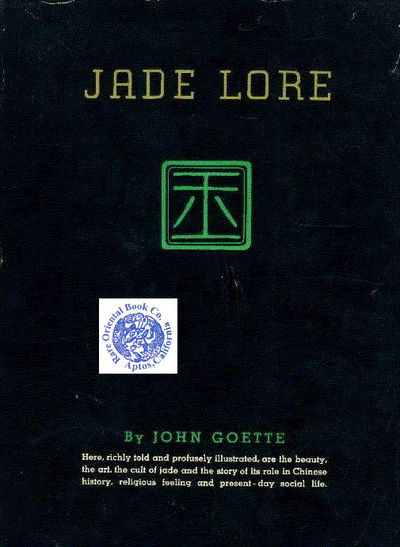
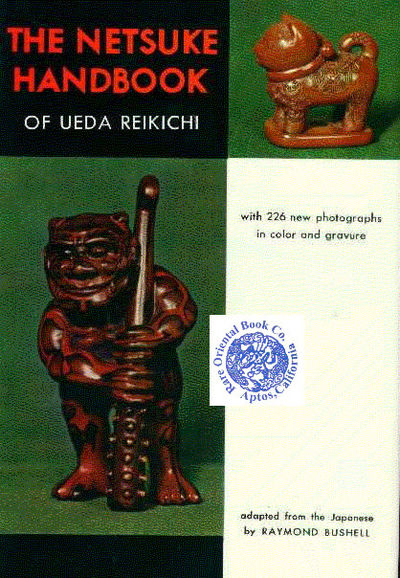
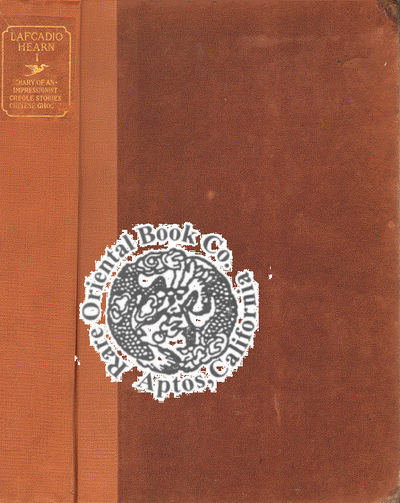
![LAFCADIO HEARN HERUN. A Journal Of The Yakumo Kai [Hearn Society] Of Matsue Japa](https://rarebookinsider.com/wp-content/uploads/2024/02/1588707918.0.l.jpg)
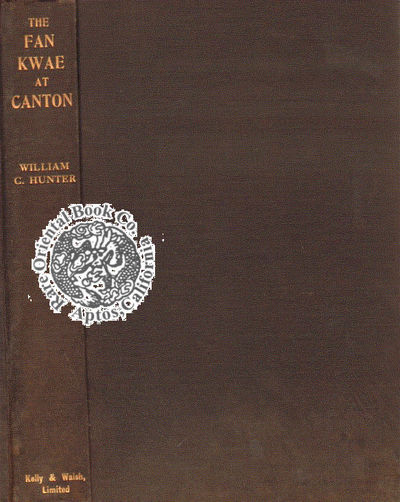
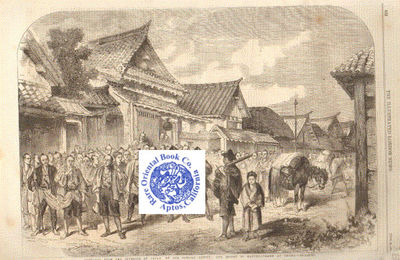
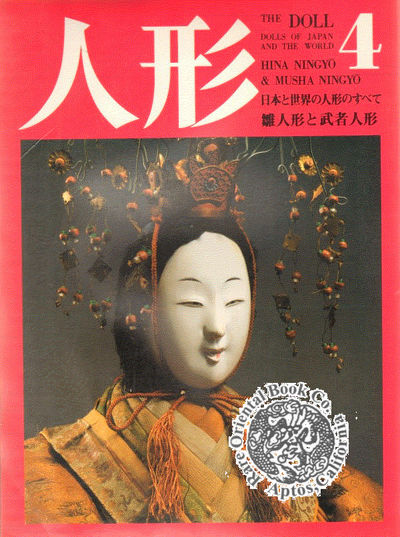
![KIRK'S JAP ROSE SOAP. [1920 Color Advertising Sheet]](https://rarebookinsider.com/wp-content/uploads/2024/03/1588707912.0.l.jpg)
